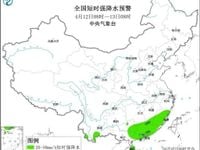As China braces for severe weather, the Mainland Central Meteorological Observatory has issued multiple warnings for strong convective weather, including strong winds, blizzards, and sandstorms. In a rare move, Beijing issued its first city-wide orange gale warning in nearly a decade on April 11, 2025, as winds intensified after nightfall, with some areas experiencing gusts reaching level 14.
In response to the escalating weather conditions, gas stations across the capital temporarily suspended refueling services, while several shopping malls offered free parking and temporary rest services for affected residents. Moreover, 15 elevated rail transit lines in Beijing announced partial suspensions starting April 12, 2025, as the city prepared for the impending storm.
Air travel was also disrupted, with the Capital Airport warning of potential flight cancellations and delays. Daxing Airport activated its emergency response protocol in anticipation of the severe weather. Iconic attractions, including the Summer Palace and the Temple of Heaven Park, will close over the weekend, with the Palace Museum also shutting its doors on April 12.
Meanwhile, in Guangdong Province, significant strong convective weather is expected, with thunderstorms, strong winds, and local hail predicted. Various departments have issued warnings, and ferry routes from Guangzhou Nansha Passenger Transport Port to Hong Kong will be suspended until April 14, 2025. Multiple water passenger transport routes in the Pearl River Estuary will also halt operations.
In Jinan, the local meteorological observatory issued a yellow gale warning on April 10, forecasting southerly winds of level 3 to level 4 and gusts of level 6 to level 7 for April 11. From the night of April 11 to April 13, northerly winds are expected to strengthen, with average wind speeds of level 5 to level 6, and gusts reaching level 8 to level 9. Jinan Airport is on high alert, having conducted multiple emergency response drills in preparation for the gale weather.
The airport has focused on improving its operational coordination, ensuring that all departments are ready to manage the challenges posed by the strong winds. Personnel have been assigned to inspect critical areas, including the airport's flight zones and public spaces, to mitigate risks associated with the weather.
As the cold air system moves from west to east across the central and eastern parts of China, it poses a significant threat to agricultural production. From April 11 to 12, temperatures in northern China are expected to plummet by 12 to 16 degrees Celsius within 24 hours, accompanied by gusts of level 8 to level 10, and localized gusts reaching level 11 to level 13. This sudden drop in temperature, combined with the strong winds, could severely impact winter wheat crops in various regions.
The Ministry of Agriculture and Rural Affairs and the China Meteorological Administration issued warnings on April 9 regarding the risks of wind and snow disasters for facility agriculture and animal husbandry. The cold air system threatens to bring a combination of cooling, strong winds, and snowfall, which could lead to frost damage for crops in critical growth stages.
In southern China, the challenges are primarily due to the impending heavy rainfall and thunderstorms. From April 11 to 12, the southwestern region, Jianghan, Jianghuai, Jiangnan, and parts of northern and eastern South China are likely to experience moderate to heavy rain, with local areas facing torrential downpours and thunderstorms.
In light of these developments, agricultural experts are advising farmers to take proactive measures to protect their crops. Zhao Xiulan, a senior engineer at the Central Meteorological Observatory, suggested that farmers in Inner Mongolia and Heilongjiang should reinforce their greenhouses and livestock shelters against the strong winds and prepare to clear snow after the storm to prevent structural damage.
For the southern regions facing heavy rainfall, farmers are urged to monitor weather forecasts closely and adjust their planting schedules accordingly to avoid planting during periods of intense precipitation. They should also take advantage of the rainfall to replenish soil moisture and ensure adequate water supply for summer crops.
In Jiangxi and Fujian, where heavy rainfall and thunderstorms are anticipated from April 11 to 13, the Nanchang Bureau Group Co., Ltd. of China Railway has issued a blue warning and initiated flood prevention protocols. This includes mobilizing over 4,000 personnel across 41 rescue teams to monitor conditions and respond to emergencies.
As part of their preparedness, the railway authorities have arranged for inspections of vulnerable areas, focusing on tunnels and embankments, and are utilizing both manual and drone surveillance to identify and address potential hazards along the railways.
In Guangdong, the Municipal Flood Control Office has urged all towns and relevant departments to ensure robust defenses against the anticipated storms. They have emphasized the need for timely preparations to safeguard lives and property, with a focus on minimizing casualties and damages.
As the weekend approaches, authorities across affected regions are urging residents to remain vigilant and prepared for the extreme weather conditions. With warnings in place and proactive measures being implemented, the hope is to mitigate the impacts of this severe weather event on both the population and agriculture.




